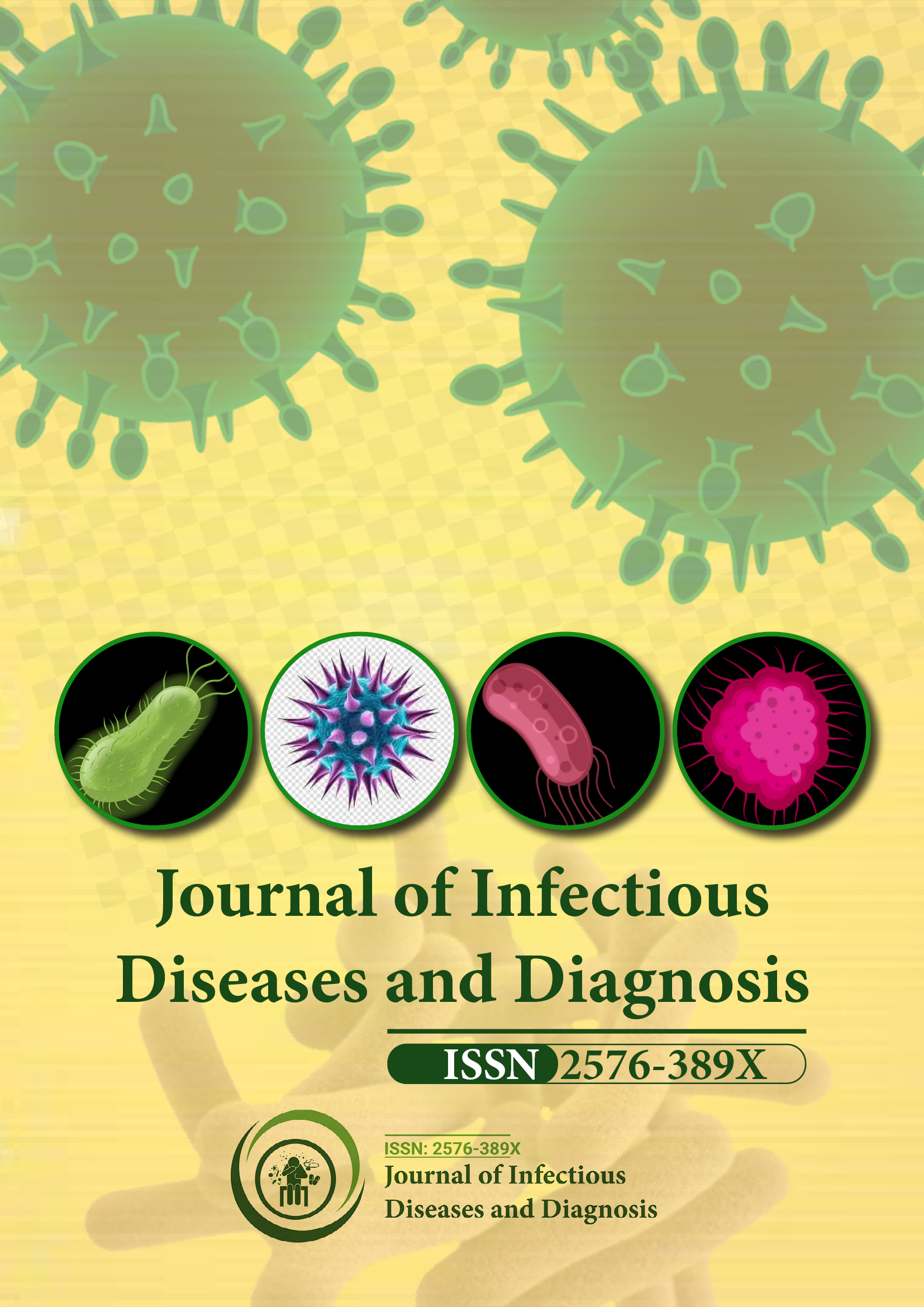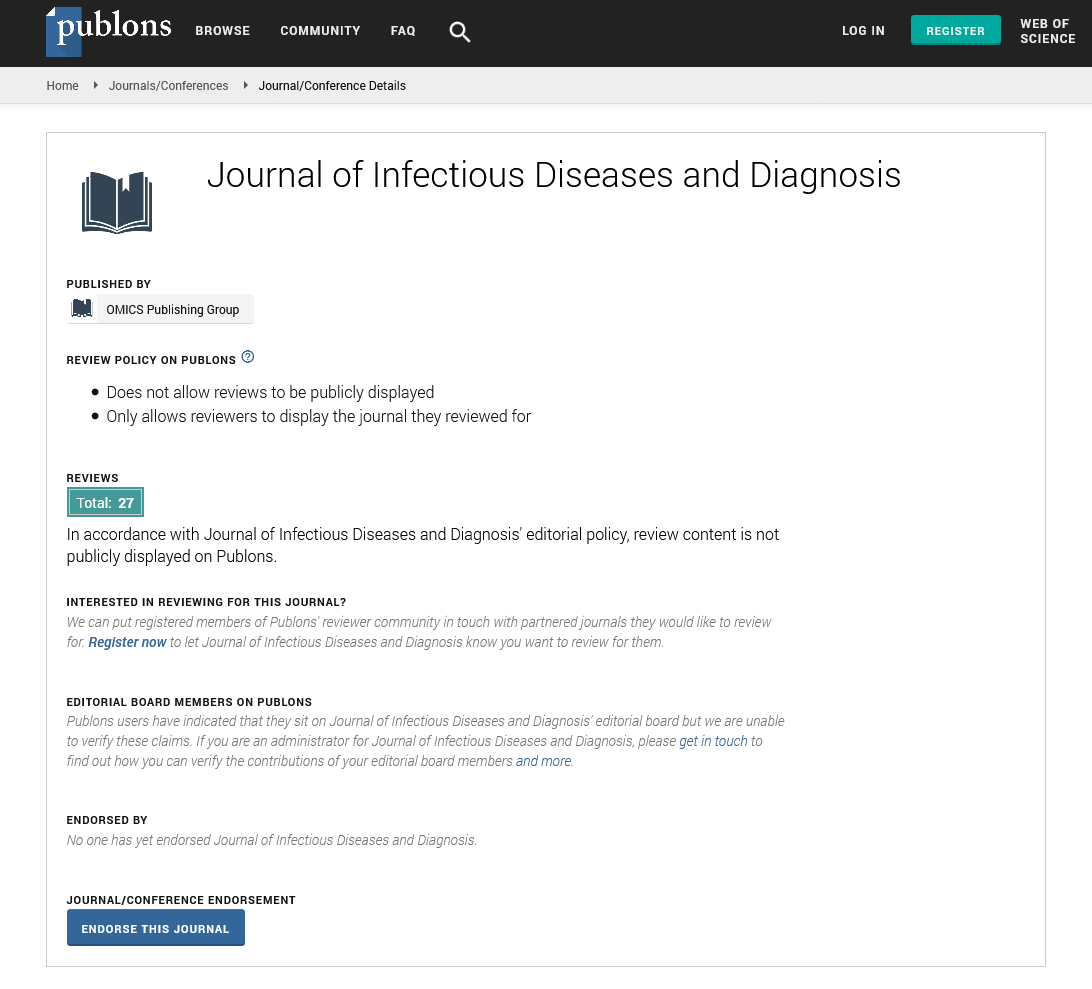Indexed In
- RefSeek
- Hamdard University
- EBSCO A-Z
- Publons
- Euro Pub
- Google Scholar
Useful Links
Share This Page
Journal Flyer

Open Access Journals
- Agri and Aquaculture
- Biochemistry
- Bioinformatics & Systems Biology
- Business & Management
- Chemistry
- Clinical Sciences
- Engineering
- Food & Nutrition
- General Science
- Genetics & Molecular Biology
- Immunology & Microbiology
- Medical Sciences
- Neuroscience & Psychology
- Nursing & Health Care
- Pharmaceutical Sciences
Perspective - (2025) Volume 10, Issue 1
Epidemiology and Prevention of Ebola Virus Disease: Current Challenges and Effective Strategies
Edwin Philips*Received: 01-Jan-2025, Manuscript No. JIDD-25-28525; Editor assigned: 03-Jan-2025, Pre QC No. JIDD-25-28525 (PQ); Reviewed: 17-Jan-2025, QC No. JIDD-25-28525; Revised: 24-Jan-2025, Manuscript No. JIDD-25-28525 (R); Published: 31-Jan-2025, DOI: 10.35248/2576-389X.25.10.313
Description
Ebola Virus Disease (EVD) is a severe and often fatal illness caused by the Ebola virus, a member of the Filoviridae family. The virus primarily affects humans and nonhuman primates, with outbreaks occurring mainly in sub-Saharan Africa. Since its discovery in 1976, EVD has caused multiple outbreaks, with varying levels of morbidity and mortality. Despite advances in surveillance and medical interventions, controlling the spread of EVD remains a major public health challenge. This manuscript examines the epidemiology of EVD, the obstacles in its prevention and the strategies required for effective disease control.
Epidemiology of Ebola virus disease
EVD is a zoonotic disease, meaning it originates in animals and can spill over to humans. The natural reservoir of the Ebola virus is believed to be fruit bats of the Pteropodidae family. The virus can be transmitted to humans through direct contact with the bodily fluids of infected animals, such as bats, nonhuman primates and possibly other mammals.
Once a human infection occurs, the virus spreads through:
• Direct contact with the blood, saliva, vomit, urine, feces, breast milk, or other bodily fluids of an infected person
• Exposure to contaminated surfaces, medical equipment, or personal items
• Handling or consumption of bush meat from infected animals
• Traditional burial practices involving direct contact with deceased individuals
• Unlike respiratory viruses, Ebola does not spread through airborne transmission, but its high fatality rate and ease of human-to-human transmission make it a serious threat.
Challenges in preventing Ebola virus disease
Early symptoms of EVD, such as fever, fatigue and muscle pain, resemble those of common tropical diseases like malaria and typhoid fever. This similarity often leads to misdiagnosis and delayed containment measures. Additionally, weak healthcare infrastructure in outbreak-prone regions limits early detection and laboratory confirmation.
Healthcare system limitations
Many regions affected by EVD have underfunded and understaffed healthcare systems. Challenges include:
• Insufficient personal protective equipment (PPE) for healthcare workers
• Lack of specialized isolation and treatment facilities
• Inadequate training on infection prevention and control measures
These gaps contribute to high transmission rates within healthcare settings, increasing risks for both medical personnel and the general population.
Cultural and behavioral factors
Traditional burial practices, which often involve direct contact with deceased individuals, have played a major role in the spread of EVD. Misinformation and distrust of health authorities also lead to resistance against containment efforts. In some communities, fear of quarantine or stigma results in individuals avoiding medical care, further fueling transmission.
Strategies for Ebola virus disease prevention
A strong surveillance system is essential for rapid outbreak detection and containment. Key components include:
• Strengthening laboratory capacity for quick diagnosis
• Establishing community-based reporting systems
• Using genomic sequencing to track viral transmission patterns
• International organizations, such as the World Health Organization (WHO) and the Centers for Disease Control and Prevention (CDC), play a vital role in coordinating global surveillance efforts.
Vaccination programs
The development of vaccines has been a major breakthrough in EVD prevention. The rVSV-ZEBOV vaccine, which provides protection against the Zaire strain of Ebola, has been used successfully in outbreak settings. Ring vaccination strategies where contacts of confirmed cases and frontline workers are vaccinated have helped control the spread of the virus. Expanding vaccine access to high-risk populations can further reduce the impact of future outbreaks.
Improved healthcare infrastructure
Strengthening healthcare systems in high-risk areas can reduce EVD transmission. This involves:
• Increasing the availability of PPE and medical supplies
• Establishing specialized treatment centers with proper infection control measures
• Training healthcare workers in outbreak preparedness and response
• Investing in long-term healthcare improvements can enhance overall epidemic readiness beyond Ebola.
Community engagement and public awareness
Effective communication strategies are essential for gaining public trust and encouraging safe practices. Measures include:
• Providing culturally sensitive education on EVD transmission and prevention
• Engaging local leaders to promote safe burial practices
• Combating misinformation through reliable media channels
• Public cooperation is critical in preventing panic and ensuring adherence to health guidelines.
Research and therapeutic advancements
Continued research is needed to develop better treatments and diagnostic tools. Several antiviral therapies, including monoclonal antibodies like Inmazeb and Ebanga, have shown promise in improving survival rates. Rapid diagnostic tests can also facilitate early case identification and containment.
Conclusion
EVD remains a significant global health threat, particularly in regions with limited resources and weak healthcare systems. While progress has been made in vaccination, surveillance and treatment, challenges such as delayed detection, healthcare infrastructure gaps and cultural barriers persist. A comprehensive approach, involving early outbreak detection, strong healthcare infrastructure, public engagement and ongoing research, is essential for preventing future epidemics. Strengthening international collaboration and preparedness efforts will play an important role in reducing the impact of EVD worldwide.
Citation: Philips E (2025). Epidemiology and Prevention of Ebola Virus Disease: Current Challenges and Effective Strategies. J Infect Dis Diagn. 10:313.
Copyright: © 2025 Philips E. This is an open-access article distributed under the terms of the Creative Commons Attribution License, which permits unrestricted use, distribution and reproduction in any medium, provided the original author and source are credited.

